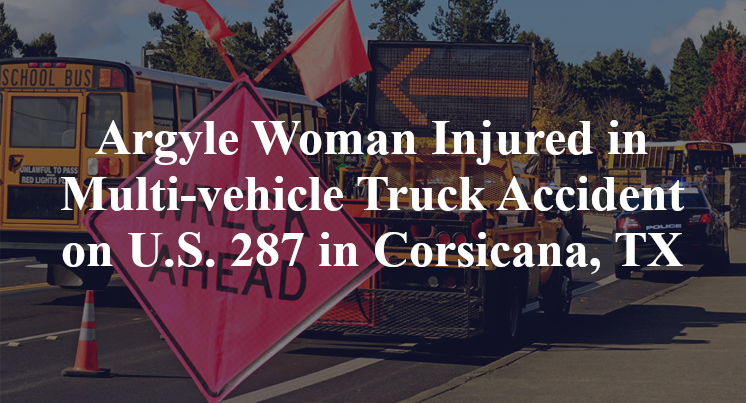Argyle Woman Injured in Multi-vehicle Truck Accident on U.S. 287 in Corsicana, TX
Navarro County, TX — January 19, 2025, a woman was injured in a multi-vehicle truck accident at approximately 4:15 p.m. along U.S. Highway 287.
According to authorities, the accident took place in the northbound lanes of U.S. Highway 287 in the vicinity south of G.W. Jackson Avenue.

The cause of the accident remains unclear. Officials indicate that, for as yet unknown reasons, a northbound Freightliner with a trailer in tow failed to appropriately control its speed. A rear-end collision and chain reaction wreck subsequently followed between the 18-wheeler and three other vehicles, one of which was a Ford F-100 occupied by a 41-year-old woman from Argyle.
The woman from the F-100 pickup truck sustained reportedly serious injuries over the course of the accident. It doesn't appear that anyone else was hurt. Additional details pertaining to this incident—including the identity of the injured woman—are not available at this point in time. The investigation is currently ongoing.
Commentary by Attorney Michael Grossman
When a commercial truck fails to control its speed and causes a chain-reaction crash, the key question isn’t just what happened, but why it happened. In my experience handling truck accident cases, these types of crashes are rarely the result of a single bad decision—there are often multiple underlying issues that need to be examined.
One possibility is driver distraction. Truck drivers rely on in-cab technology such as GPS, dispatch communications, and electronic logging devices (ELDs), all of which can divert attention from the road. Investigators should review dashcam footage, phone records, and in-cab data to determine whether distraction played a role in the driver’s failure to slow down in time.
Another critical factor is whether the truck driver was following at a safe distance. Large commercial vehicles require significantly more stopping distance than passenger cars, particularly at highway speeds. If the driver was tailgating or not paying close attention to traffic patterns, they may not have had enough time to react when the vehicles ahead slowed down.
Fatigue is another potential concern. Federal regulations limit the number of hours a trucker can drive before taking a mandatory break, but those rules only work if they’re followed. If the driver had been on the road for an extended period without adequate rest, their ability to react quickly may have been compromised. Hours-of-service logs and ELD data will be important in determining whether fatigue played a role.
The trucking company’s role should also be examined. Was the driver properly trained in defensive driving and safe following distances? Did the company impose unrealistic delivery schedules that pressured the driver to speed or take risks? A company that prioritizes efficiency over safety can create conditions where crashes like this become more likely. Reviewing company policies and past safety violations may reveal whether this was an isolated mistake or part of a larger pattern.
Ultimately, the goal is to uncover the truth and provide answers to those affected by the crash. Even if it requires conducting an independent investigation to obtain critical evidence, it’s essential to examine every factor to ensure those impacted by the incident receive the clarity and closure they deserve.

“These are essential reads for anyone dealing with the aftermath of a truck wreck”– Attorney Cory Carlson